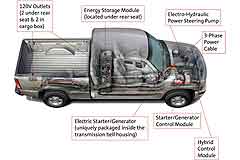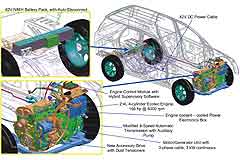Gasoline prices are soaring, hybrids are hot and American automakers are playing catch-up in offering these fuel savers. For instance, General Motors will offer its new Belt Alternator Starter (BAS) mild hybrid system on the Saturn Vue Green Line SUV in mid-2006. Later, the BAS system will be available on the Malibu mid-size sedan and, probably, other vehicles. GM says, BAS can be easily mated to various engine designs with minimal changes, and for an attractive price. BAS should increase fuel economy by 10- to 12-percent.

There are two basic types of hybrid electric vehicles - full or mild. Full hybrids, like the Toyota Prius and Highlander, Lexus 400h, Ford Escape and Mercury Mariner, can operate on the electric motor or gasoline engine alone, or both when maximum power is needed. In a mild hybrid, the electric motor only supplements the gasoline engine when extra power is needed. A mild hybrid cannot be driven on electric power alone. In both, the motor is also used for the stop/start operation and a generator is integrated with the electric motor to recharge the battery and recover energy during regenerative braking. Full hybrids are more complex, and thus more expensive, because they have more powerful electric motor/generators and larger batteries. Off-setting the higher cost is the greater fuel savings provided by a full hybrid over a mild hybrid.
GM’s BAS system consists of a motor/generator with stop-start capability and regenerative braking with motive power assistance. The BAS system cuts off fuel during deceleration and shuts off the engine at idle. Release the brake, and belt alternator starter instantly restarts the engine. Regenerative braking further improves fuel economy. All vehicle accessories and passenger comfort systems operate while the engine is shut off. During an aggressive passing maneuver, the system assists the 2.4-liter Ecotec, four-cylinder engine.

In the generating mode, the BAS system provides both 12-Volt vehicle accessory power and keeps the hybrid system’s 42-Volt Nickel Metal Hydrid (NiMH) battery charged. This battery can receive and deliver over 10 kilowatt of peak power. Both motoring and generating power is transferred to the 4T45-E electronically controlled overdrive transaxle via a new engine accessory drive. The drive uses a dual tensioner assembly and Aramid cord belt. As with all hybrids, the greatest full savings comes instop-and-go urban traffic by shutting down the engine rather than idling and through regenerative braking. Indeed, most hybrids have higher city EPA mpg ratings than highway ones.
General Motors currently offers its Chevrolet Silverado Hybrid and GMC Sierra Hybrid pickups that use GM’s Flywheel Alternator Starter (FAS) hybrid system. Here a compact motor/alternator is located between the Vortec 5300 V8 engine and the automatic transmission. Electricity is stored in a 42-volt lead-acid battery pack located under the rear seat.
As the pickup slows down and brakes to a stop, the engine supply shuts down. Then, the electric motor provides fast, quiet starting power to get going again. The system does not augment the gasoline engine so power output and towing capacity is the same as the non-hybrid version. The system provides a 10 to 12-percent improvement in fuel economy. The big selling point for many buyers is the ability to provide 120-volt, 20 ampere AC power via four, conventional, three-prong plug-ins. Two are under the rear seat, and two more in the back of the pickup bed. This auxiliary power is generated while traveling and when parked. This generator can provide power for up to 32 hours non-stop on a full tank. It does shut off before the gas tank is completely drained.




